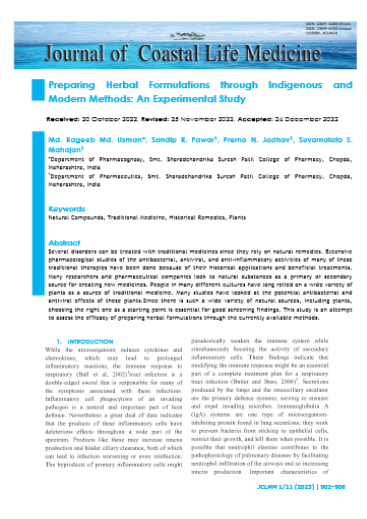Preparing Herbal Formulations through Indigenous and Modern Methods: An Experimental Study
Main Article Content
Abstract
Several disorders can be treated with traditional medicines since they rely on natural remedies. Extensive pharmacological studies of the antibacterial, antiviral, and anti-inflammatory activities of many of these traditional therapies have been done because of their historical applications and beneficial treatments. Many researchers and pharmaceutical companies look to natural substances as a primary or secondary source for creating new medicines. People in many different cultures have long relied on a wide variety of plants as a source of traditional medicine. Many studies have looked at the potential antibacterial and antiviral effects of these plants.Since there is such a wide variety of natural sources, including plants, choosing the right one as a starting point is essential for good screening findings. This study is an attempt to assess the efficacy of preparing herbal formulations through the currently available methods.
Article Details
References
Ball P., Baquero F., Cars O., File T., Garau J., Klugman K. Antibiotic therapy of community respiratory tract infections: strategies for optimal outcomes and minimized resistance emergence. J AntimicrobChemother. 2002;49(1):31–40.
Butler M.S., Buss A.D. Natural products—the future scaffolds for novel antibiotics? BiochemPharmacol. 2006;71(7):919–929.
Shafran S.D., Singer J., Zarowny D.P., Phillips P., Salit I., Walmsley S.L. A comparison of two regimens for the treatment of Mycobacterium avium complex bacteremia in AIDS: rifabutin, ethambutol, and clarithromycin versus rifampin, ethambutol, clofazimine, and ciprofloxacin. New Engl J Med. 1996;335(6):377–384.
Cowan M.M. Plant products as antimicrobial agents. ClinMicrobiol Rev. 1999;12(4):564–582.
Iwu M., Duncan A.R., Okunji C.O. Perspectives on new crops and new uses. ASHS Press; Alexandria, VA: 1999. New antimicrobials of plant origin; pp. 457–462.
Das K., Tiwari R., Shrivastava D. Techniques for evaluation of medicinal plant products as antimicrobial agent: Current methods and future trends. J Med Plants Res. 2010;4(2):104–111
Matu E.N., Van Staden J. Antibacterial and anti-inflammatory activities of some plants used for medicinal purposes in Kenya. JEthnopharmacol.2003;87 (1):35–41.
Konstan M.W., Vargo K.M., Davis P.B. Ibuprofen attenuates the inflammatory response to Pseudomonas aeruginosa in a rat model of chronic pulmonary infection. Am Rev Respir Dis. 1990;141:186–192
Barnes P.J., Belvisi M.G., Rogers D.F. Modulation of neurogenic inflammation: novel approaches to inflammatory disease. Trends Pharmacol Sci. 1990;11(5):185–189.
Lopez P., Sanchez C., Batlle R., Nerin C. Solid-and vapor phase antimicrobial activities of six essential oils: susceptibility of selected foodborne bacterial and fungal strains. J Agric Food Chem. 2005;53(17):6939–6946.
Pasdaran A., Pasdaran A., and Sheikhi D. Volatile oils: Potential agents for the treatment of respiratory infections. The Microbiology of Respiratory System Infections. 2016: 237–261.

